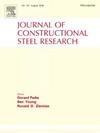Topology optimization and diverse truss designs considering nodal stability and bar buckling
IF 4
2区 工程技术
Q1 CONSTRUCTION & BUILDING TECHNOLOGY
引用次数: 0
Abstract
Ensuring the bar stability is crucial in truss design. However, unstable nodes lacking lateral support complicate the calculation of bar buckling lengths. bar buckling constraints make the feasible region of optimization problems concave, further complicating the solution process. Moreover, traditional truss optimization methods typically yield a single optimal result, limiting the design options available to engineers. In this study, nominal disturbing load conditions are applied to the structure to eliminate unstable nodes, thereby ensuring accurate buckling length calculations. Additionally, the advanced allowable stress iteration (AASI) approach is proposed to address truss optimization problems with bar buckling constraints. To generate geometrically diverse and structurally competitive trusses, we develop a bar-length penalty (BLP) method. To validate the effectiveness of these methods, three numerical studies are presented. The results demonstrate that the proposed AASI approach produces optimized structures free from unstable nodes and bar buckling. Compared to structures optimized using the allowable stress iteration (ASI) method, which can only optimize for a single load case, those designed with the new approach maintain bar stability under all load conditions. Compared to the traditional method of increasing the cross-sectional area of unstable bars to ensure stability, much lighter trusses can be generated while maintaining the same load-bearing capacity. By applying the proposed BLP method to penalize specific bars, it is possible to achieve optimized structures with distinct topologies, similar masses, and equivalent load-carrying capacities. The proposed methods provide valuable insights for truss optimization design.
考虑节点稳定性和杆件屈曲的拓扑优化和多样化桁架设计
在桁架设计中,确保杆件的稳定性至关重要。然而,缺乏侧向支撑的不稳定节点会使杆件屈曲长度的计算复杂化。杆件屈曲约束会使优化问题的可行区域呈凹形,从而使求解过程更加复杂。此外,传统的桁架优化方法通常只产生一个最优结果,限制了工程师的设计选择。在本研究中,对结构施加了额定干扰载荷条件,以消除不稳定节点,从而确保屈曲长度计算的准确性。此外,还提出了先进的容许应力迭代(AASI)方法,以解决具有杆件屈曲约束的桁架优化问题。为了生成几何上多样化、结构上有竞争力的桁架,我们开发了一种杆件长度惩罚(BLP)方法。为了验证这些方法的有效性,我们进行了三项数值研究。研究结果表明,所提出的 AASI 方法可以优化结构,避免出现不稳定节点和杆件屈曲。使用容许应力迭代法(ASI)优化的结构只能针对单一载荷情况进行优化,与之相比,使用新方法设计的结构在所有载荷条件下都能保持杆件稳定性。与增加不稳定杆件的横截面积以确保稳定性的传统方法相比,在保持相同承载能力的情况下,桁架的重量要轻很多。通过应用所提出的 BLP 方法对特定杆件进行惩罚,可以获得拓扑结构不同、质量相似、承载能力相当的优化结构。所提出的方法为桁架优化设计提供了宝贵的见解。
本文章由计算机程序翻译,如有差异,请以英文原文为准。
求助全文
约1分钟内获得全文
求助全文
来源期刊

Journal of Constructional Steel Research
工程技术-工程:土木
CiteScore
7.90
自引率
19.50%
发文量
550
审稿时长
46 days
期刊介绍:
The Journal of Constructional Steel Research provides an international forum for the presentation and discussion of the latest developments in structural steel research and their applications. It is aimed not only at researchers but also at those likely to be most affected by research results, i.e. designers and fabricators. Original papers of a high standard dealing with all aspects of steel research including theoretical and experimental research on elements, assemblages, connection and material properties are considered for publication.
 求助内容:
求助内容: 应助结果提醒方式:
应助结果提醒方式:


